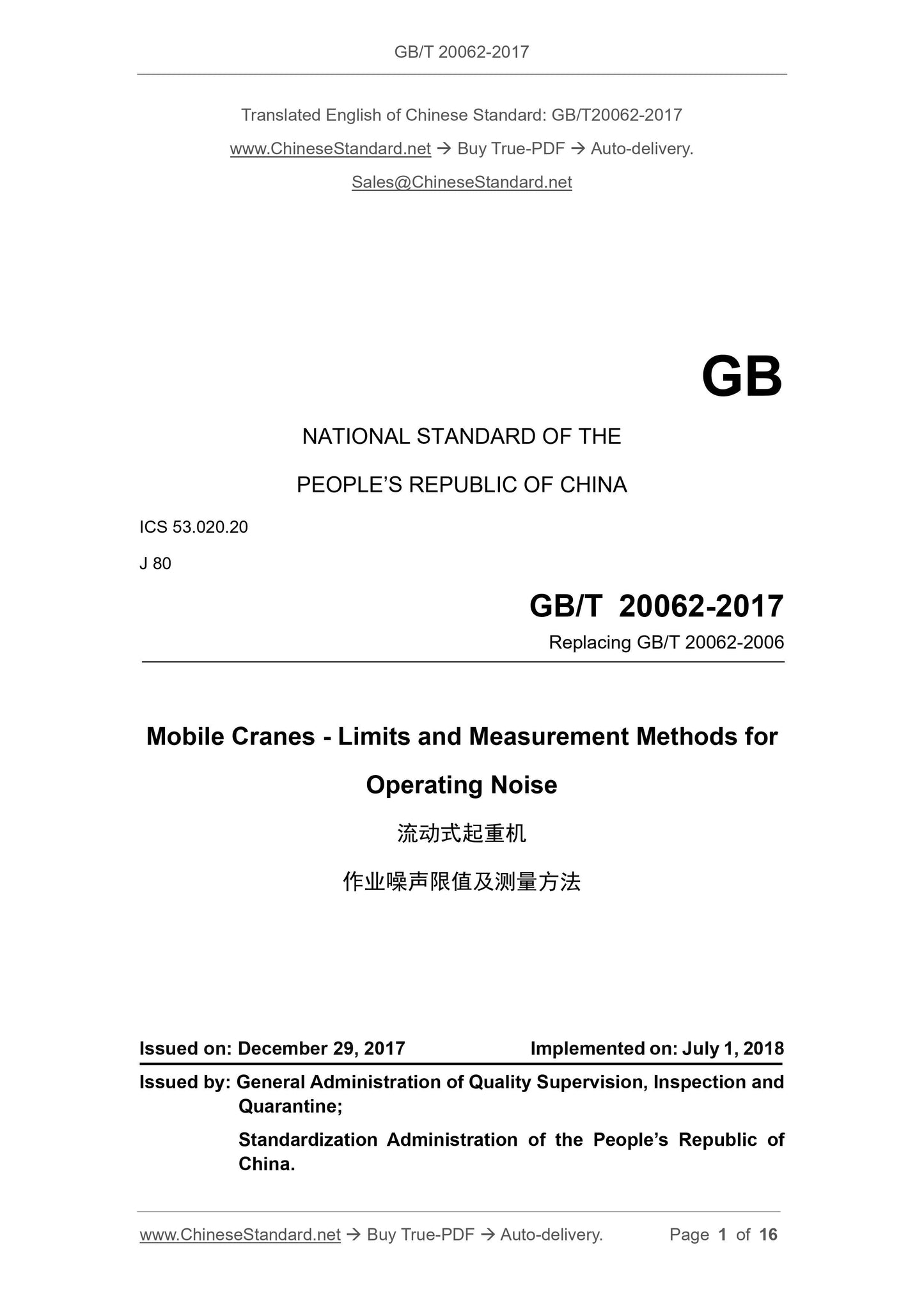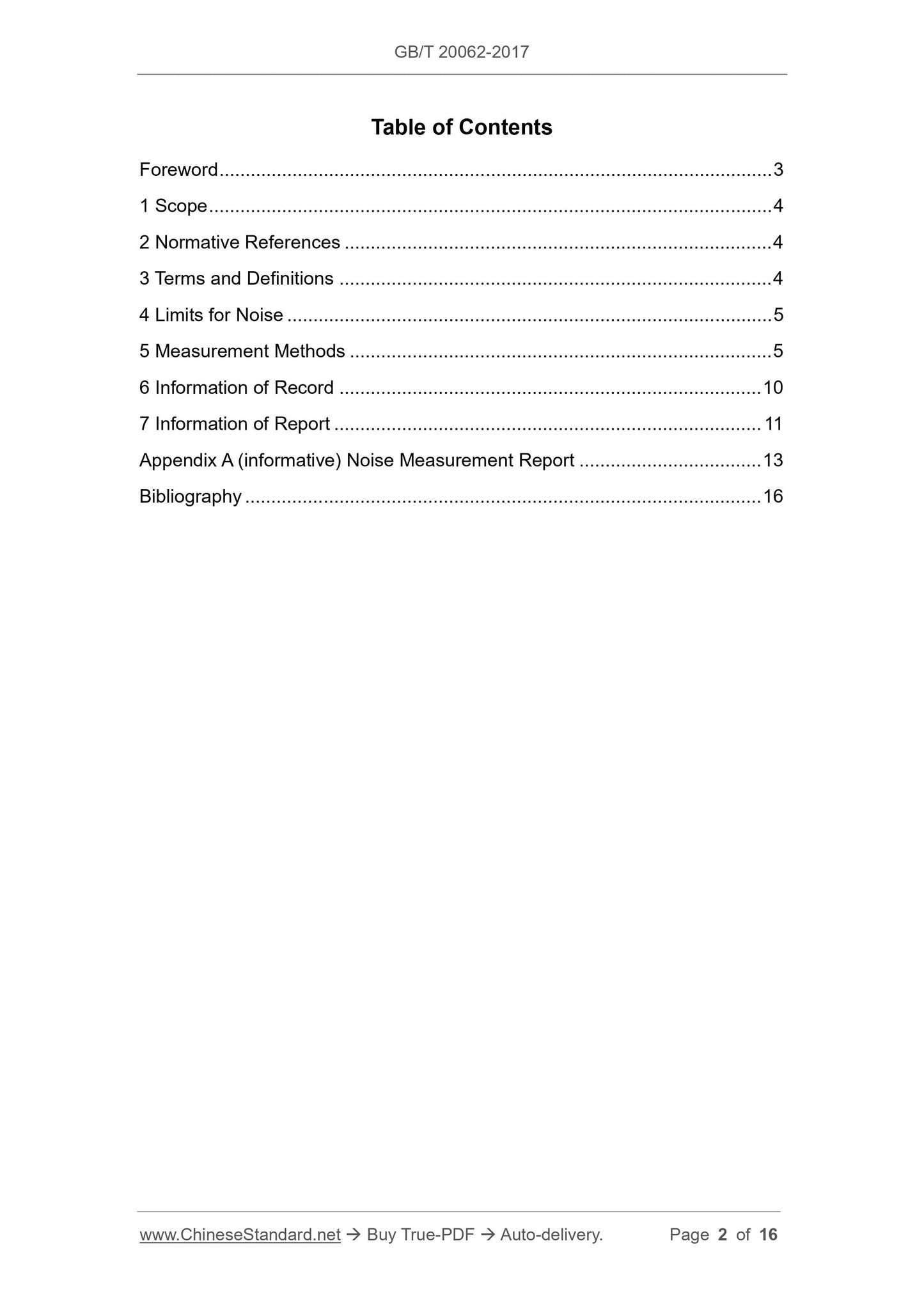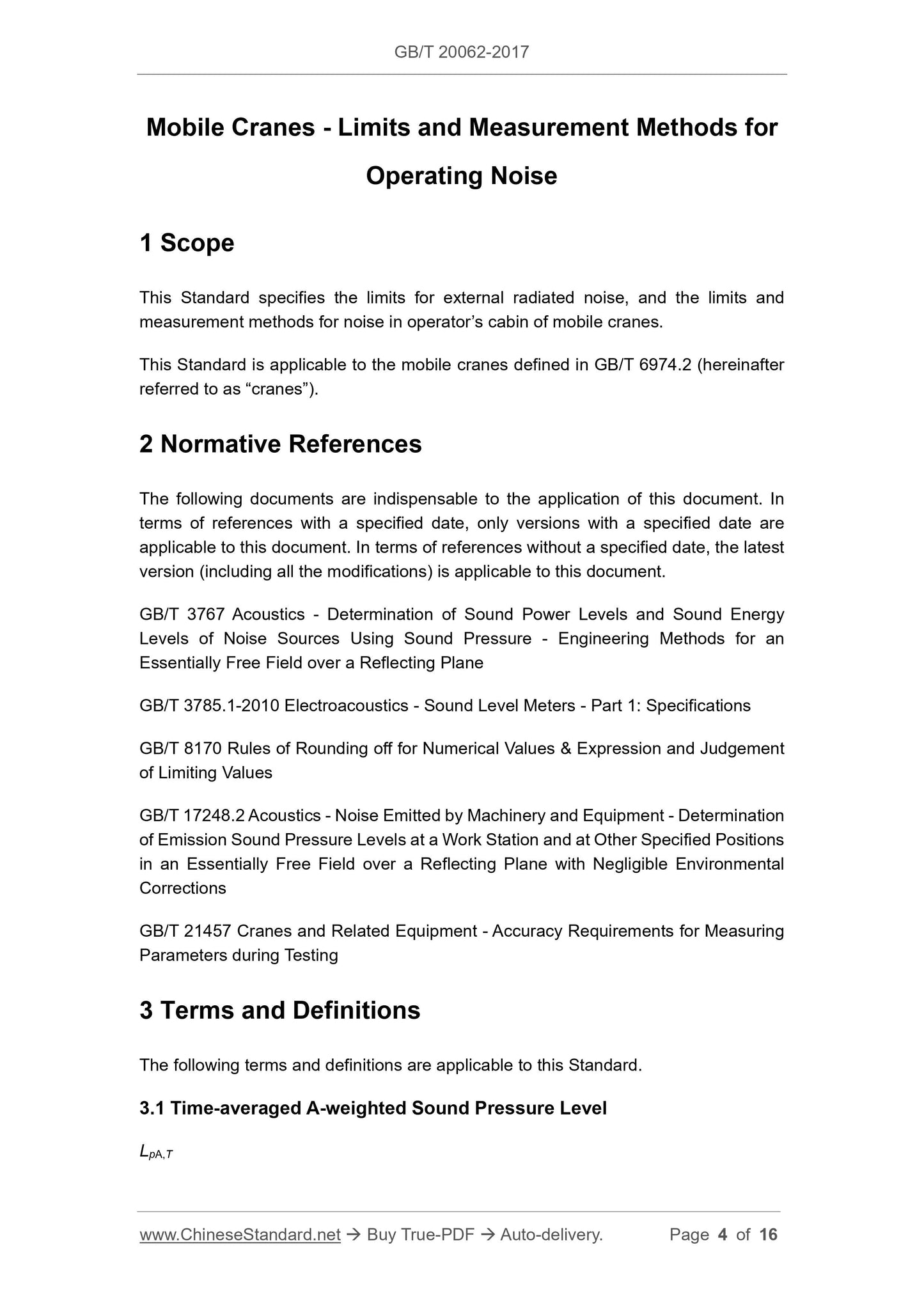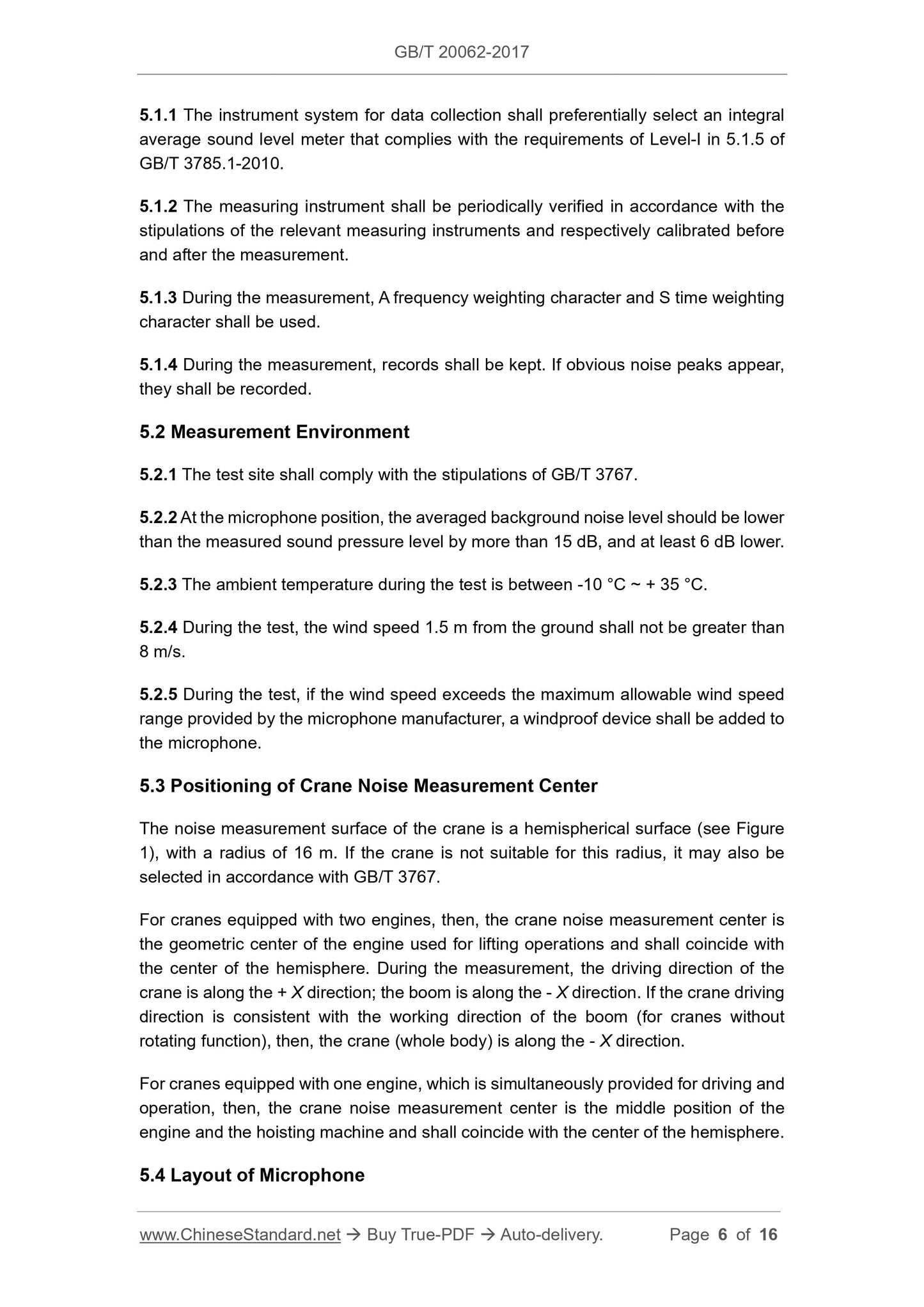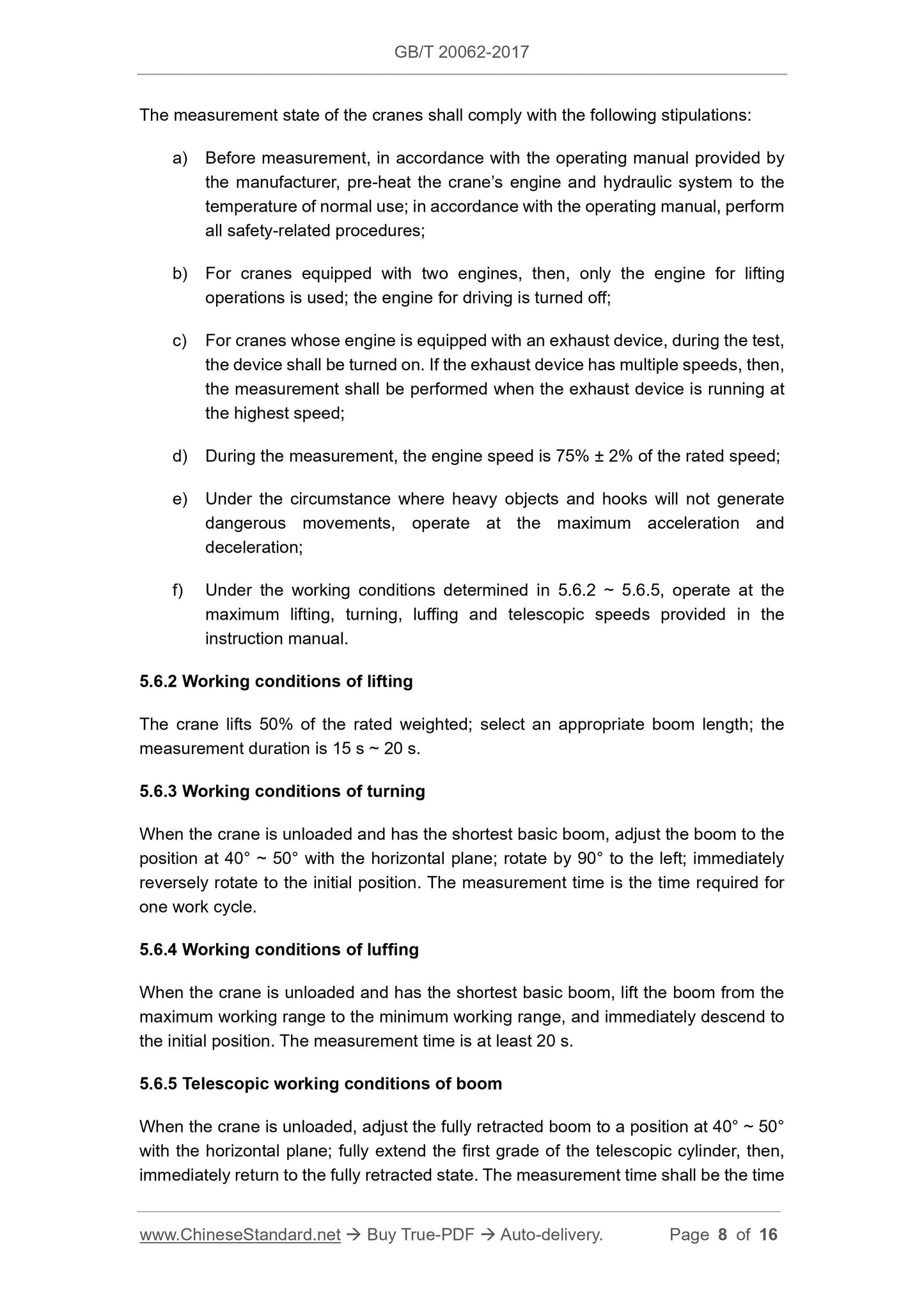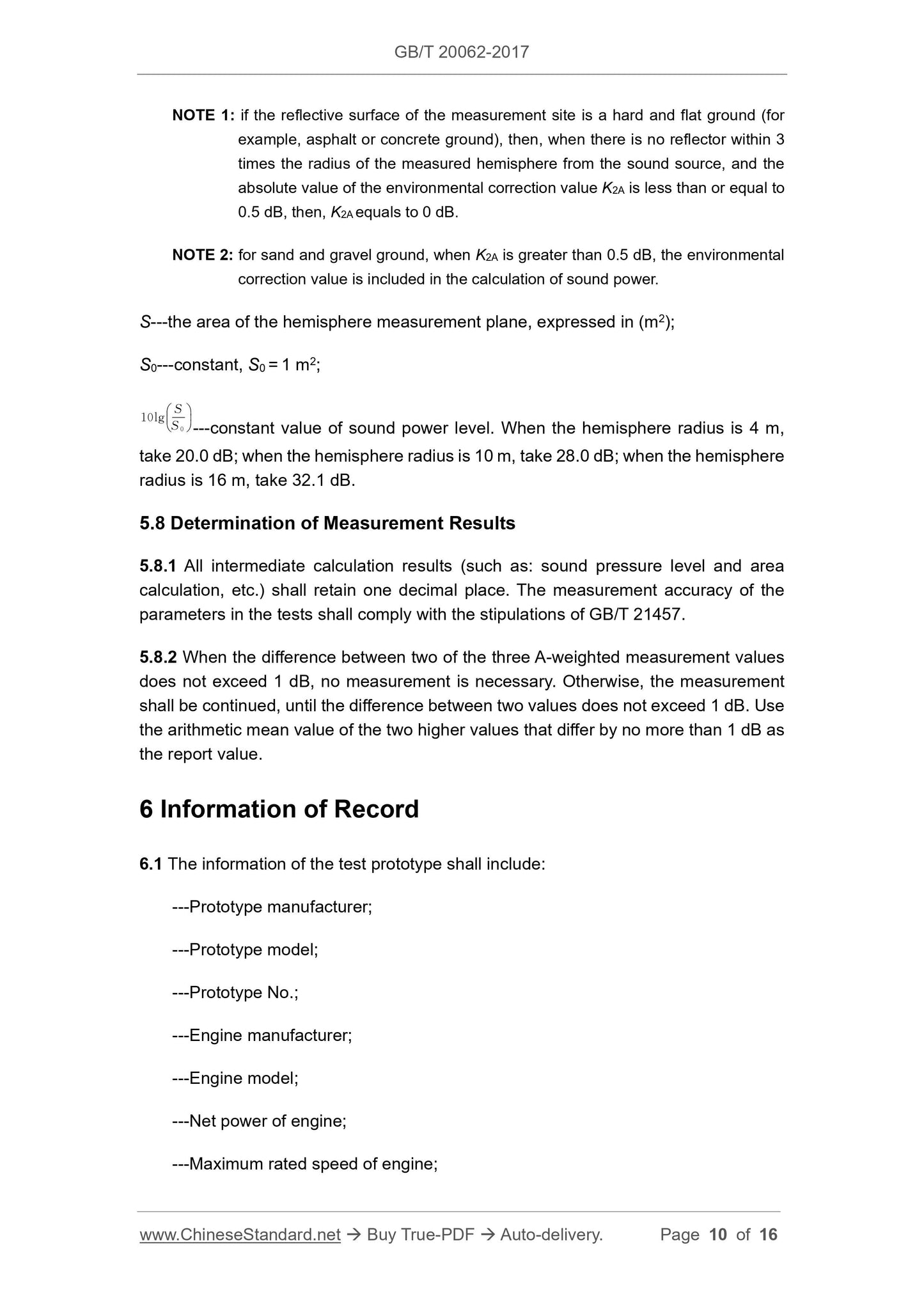1
/
of
6
PayPal, credit cards. Download editable-PDF & invoice In 1 second!
GB/T 20062-2017 English PDF (GBT20062-2017)
GB/T 20062-2017 English PDF (GBT20062-2017)
Regular price
$230.00 USD
Regular price
Sale price
$230.00 USD
Unit price
/
per
Shipping calculated at checkout.
Couldn't load pickup availability
Delivery: 3 seconds. Download true-PDF + Invoice.
Get QUOTATION in 1-minute: Click GB/T 20062-2017
Historical versions: GB/T 20062-2017
Preview True-PDF (Reload/Scroll if blank)
GB/T 20062-2017: Mobile cranes -- Limits and measurement methods for operating noise
GB/T 20062-2017
GB
NATIONAL STANDARD OF THE
PEOPLE’S REPUBLIC OF CHINA
ICS 53.020.20
J 80
Replacing GB/T 20062-2006
Mobile Cranes - Limits and Measurement Methods for
Operating Noise
ISSUED ON: DECEMBER 29, 2017
IMPLEMENTED ON: JULY 1, 2018
Issued by: General Administration of Quality Supervision, Inspection and
Quarantine;
Standardization Administration of the People’s Republic of
China.
Table of Contents
Foreword ... 3
1 Scope ... 4
2 Normative References ... 4
3 Terms and Definitions ... 4
4 Limits for Noise ... 5
5 Measurement Methods ... 5
6 Information of Record ... 10
7 Information of Report ... 11
Appendix A (informative) Noise Measurement Report ... 13
Bibliography ... 16
Mobile Cranes - Limits and Measurement Methods for
Operating Noise
1 Scope
This Standard specifies the limits for external radiated noise, and the limits and
measurement methods for noise in operator’s cabin of mobile cranes.
This Standard is applicable to the mobile cranes defined in GB/T 6974.2 (hereinafter
referred to as “cranes”).
2 Normative References
The following documents are indispensable to the application of this document. In
terms of references with a specified date, only versions with a specified date are
applicable to this document. In terms of references without a specified date, the latest
version (including all the modifications) is applicable to this document.
GB/T 3767 Acoustics - Determination of Sound Power Levels and Sound Energy
Levels of Noise Sources Using Sound Pressure - Engineering Methods for an
Essentially Free Field over a Reflecting Plane
GB/T 3785.1-2010 Electroacoustics - Sound Level Meters - Part 1: Specifications
GB/T 8170 Rules of Rounding off for Numerical Values and Expression and Judgement
of Limiting Values
GB/T 17248.2 Acoustics - Noise Emitted by Machinery and Equipment - Determination
of Emission Sound Pressure Levels at a Work Station and at Other Specified Positions
in an Essentially Free Field over a Reflecting Plane with Negligible Environmental
Corrections
GB/T 21457 Cranes and Related Equipment - Accuracy Requirements for Measuring
Parameters during Testing
3 Terms and Definitions
The following terms and definitions are applicable to this Standard.
3.1 Time-averaged A-weighted Sound Pressure Level
LpA,T
5.1.1 The instrument system for data collection shall preferentially select an integral
average sound level meter that complies with the requirements of Level-I in 5.1.5 of
GB/T 3785.1-2010.
5.1.2 The measuring instrument shall be periodically verified in accordance with the
stipulations of the relevant measuring instruments and respectively calibrated before
and after the measurement.
5.1.3 During the measurement, A frequency weighting character and S time weighting
character shall be used.
5.1.4 During the measurement, records shall be kept. If obvious noise peaks appear,
they shall be recorded.
5.2 Measurement Environment
5.2.1 The test site shall comply with the stipulations of GB/T 3767.
5.2.2 At the microphone position, the averaged background noise level should be lower
than the measured sound pressure level by more than 15 dB, and at least 6 dB lower.
5.2.3 The ambient temperature during the test is between -10 °C ~ + 35 °C.
5.2.4 During the test, the wind speed 1.5 m from the ground shall not be greater than
8 m/s.
5.2.5 During the test, if the wind speed exceeds the maximum allowable wind speed
range provided by the microphone manufacturer, a windproof device shall be added to
the microphone.
5.3 Positioning of Crane Noise Measurement Center
The noise measurement surface of the crane is a hemispherical surface (see Figure
1), with a radius of 16 m. If the crane is not suitable for this radius, it may also be
selected in accordance with GB/T 3767.
For cranes equipped with two engines, then, the crane noise measurement center is
the geometric center of the engine used for lifting operations and shall coincide with
the center of the hemisphere. During the measurement, the driving direction of the
crane is along the + X direction; the boom is along the - X direction. If the crane driving
direction is consistent with the working direction of the boom (for cranes without
rotating function), then, the crane (whole body) is along the - X direction.
For cranes equipped with one engine, which is simultaneously provided for driving and
operation, then, the crane noise measurement center is the middle position of the
engine and the hoisting machine and shall coincide with the center of the hemisphere.
5.4 Layout of Microphone
The measurement state of the cranes shall comply with the following stipulations:
a) Before measurement, in accordance with the operating manual provided by
the manufacturer, pre-heat the crane’s engine and hydraulic system to the
temperature of normal use; in accordance with the operating manual, perform
all safety-related procedures;
b) For cranes equipped with two engines, then, only the engine for lifting
operations is used; the engine for driving is turned off;
c) For cranes whose engine is equipped with an exhaust device, during the test,
the device shall be turned on. If the exhaust device has multiple speeds, then,
the measurement shall be performed when the exhaust device is running at
the highest speed;
d) During the measurement, the engine speed is 75% ± 2% of the rated speed;
e) Under the circumstance where heavy objects and hooks will not generate
dangerous movements, operate at the maximum acceleration and
deceleration;
f) Under the working conditions determined in 5.6.2 ~ 5.6.5, operate at the
maximum lifting, turning, luffing and telescopic speeds provided in the
instruction manual.
5.6.2 Working conditions of lifting
The crane lifts 50% of the rated weighted; select an appropriate boom length; the
measurement duration is 15 s ~ 20 s.
5.6.3 Working conditions of turning
When the crane is unloaded and has the shortest basic boom, adjust the boom to the
position at 40° ~ 50° with the horizontal plane; rotate by 90° to the left; immediately
reversely rotate to the initial position. The measurement time is the time required for
one work cycle.
5.6.4 Working conditions of luffing
When the crane is unloaded and has the shortest basic boom, lift the boom from the
maximum working range to the minimum working range, and immediately descend to
the initial position. The measurement time is at least 20 s.
5.6.5 Telescopic working conditions of boom
When the crane is unloaded, adjust the fully retracted boom to a position at 40° ~ 50°
with the horizontal plane; fully extend the first grade of the telescopic cylinder, then,
immediately return to the fully retracted state. The measurement time shall be the time
NOTE 1: if the reflective surface of the measurement site is a hard and flat ground (for
example, asphalt or concrete ground), then, when there is no reflector within 3
times the radius of the measured hemisphere from the sound source, and the
absolute value of the environmental correction value K2A is less than or equal to
0.5 dB, then, K2A equals to 0 dB.
NOTE 2: for sand and gravel ground, when K2A is greater than 0.5 dB, the environmental
correction value is included in the calculation of sound power.
S---the area of the hemisphere measurement plane, expressed in (m2);
S0---constant, S0 = 1 m2;
---constant value of sound power level. When th...
Get QUOTATION in 1-minute: Click GB/T 20062-2017
Historical versions: GB/T 20062-2017
Preview True-PDF (Reload/Scroll if blank)
GB/T 20062-2017: Mobile cranes -- Limits and measurement methods for operating noise
GB/T 20062-2017
GB
NATIONAL STANDARD OF THE
PEOPLE’S REPUBLIC OF CHINA
ICS 53.020.20
J 80
Replacing GB/T 20062-2006
Mobile Cranes - Limits and Measurement Methods for
Operating Noise
ISSUED ON: DECEMBER 29, 2017
IMPLEMENTED ON: JULY 1, 2018
Issued by: General Administration of Quality Supervision, Inspection and
Quarantine;
Standardization Administration of the People’s Republic of
China.
Table of Contents
Foreword ... 3
1 Scope ... 4
2 Normative References ... 4
3 Terms and Definitions ... 4
4 Limits for Noise ... 5
5 Measurement Methods ... 5
6 Information of Record ... 10
7 Information of Report ... 11
Appendix A (informative) Noise Measurement Report ... 13
Bibliography ... 16
Mobile Cranes - Limits and Measurement Methods for
Operating Noise
1 Scope
This Standard specifies the limits for external radiated noise, and the limits and
measurement methods for noise in operator’s cabin of mobile cranes.
This Standard is applicable to the mobile cranes defined in GB/T 6974.2 (hereinafter
referred to as “cranes”).
2 Normative References
The following documents are indispensable to the application of this document. In
terms of references with a specified date, only versions with a specified date are
applicable to this document. In terms of references without a specified date, the latest
version (including all the modifications) is applicable to this document.
GB/T 3767 Acoustics - Determination of Sound Power Levels and Sound Energy
Levels of Noise Sources Using Sound Pressure - Engineering Methods for an
Essentially Free Field over a Reflecting Plane
GB/T 3785.1-2010 Electroacoustics - Sound Level Meters - Part 1: Specifications
GB/T 8170 Rules of Rounding off for Numerical Values and Expression and Judgement
of Limiting Values
GB/T 17248.2 Acoustics - Noise Emitted by Machinery and Equipment - Determination
of Emission Sound Pressure Levels at a Work Station and at Other Specified Positions
in an Essentially Free Field over a Reflecting Plane with Negligible Environmental
Corrections
GB/T 21457 Cranes and Related Equipment - Accuracy Requirements for Measuring
Parameters during Testing
3 Terms and Definitions
The following terms and definitions are applicable to this Standard.
3.1 Time-averaged A-weighted Sound Pressure Level
LpA,T
5.1.1 The instrument system for data collection shall preferentially select an integral
average sound level meter that complies with the requirements of Level-I in 5.1.5 of
GB/T 3785.1-2010.
5.1.2 The measuring instrument shall be periodically verified in accordance with the
stipulations of the relevant measuring instruments and respectively calibrated before
and after the measurement.
5.1.3 During the measurement, A frequency weighting character and S time weighting
character shall be used.
5.1.4 During the measurement, records shall be kept. If obvious noise peaks appear,
they shall be recorded.
5.2 Measurement Environment
5.2.1 The test site shall comply with the stipulations of GB/T 3767.
5.2.2 At the microphone position, the averaged background noise level should be lower
than the measured sound pressure level by more than 15 dB, and at least 6 dB lower.
5.2.3 The ambient temperature during the test is between -10 °C ~ + 35 °C.
5.2.4 During the test, the wind speed 1.5 m from the ground shall not be greater than
8 m/s.
5.2.5 During the test, if the wind speed exceeds the maximum allowable wind speed
range provided by the microphone manufacturer, a windproof device shall be added to
the microphone.
5.3 Positioning of Crane Noise Measurement Center
The noise measurement surface of the crane is a hemispherical surface (see Figure
1), with a radius of 16 m. If the crane is not suitable for this radius, it may also be
selected in accordance with GB/T 3767.
For cranes equipped with two engines, then, the crane noise measurement center is
the geometric center of the engine used for lifting operations and shall coincide with
the center of the hemisphere. During the measurement, the driving direction of the
crane is along the + X direction; the boom is along the - X direction. If the crane driving
direction is consistent with the working direction of the boom (for cranes without
rotating function), then, the crane (whole body) is along the - X direction.
For cranes equipped with one engine, which is simultaneously provided for driving and
operation, then, the crane noise measurement center is the middle position of the
engine and the hoisting machine and shall coincide with the center of the hemisphere.
5.4 Layout of Microphone
The measurement state of the cranes shall comply with the following stipulations:
a) Before measurement, in accordance with the operating manual provided by
the manufacturer, pre-heat the crane’s engine and hydraulic system to the
temperature of normal use; in accordance with the operating manual, perform
all safety-related procedures;
b) For cranes equipped with two engines, then, only the engine for lifting
operations is used; the engine for driving is turned off;
c) For cranes whose engine is equipped with an exhaust device, during the test,
the device shall be turned on. If the exhaust device has multiple speeds, then,
the measurement shall be performed when the exhaust device is running at
the highest speed;
d) During the measurement, the engine speed is 75% ± 2% of the rated speed;
e) Under the circumstance where heavy objects and hooks will not generate
dangerous movements, operate at the maximum acceleration and
deceleration;
f) Under the working conditions determined in 5.6.2 ~ 5.6.5, operate at the
maximum lifting, turning, luffing and telescopic speeds provided in the
instruction manual.
5.6.2 Working conditions of lifting
The crane lifts 50% of the rated weighted; select an appropriate boom length; the
measurement duration is 15 s ~ 20 s.
5.6.3 Working conditions of turning
When the crane is unloaded and has the shortest basic boom, adjust the boom to the
position at 40° ~ 50° with the horizontal plane; rotate by 90° to the left; immediately
reversely rotate to the initial position. The measurement time is the time required for
one work cycle.
5.6.4 Working conditions of luffing
When the crane is unloaded and has the shortest basic boom, lift the boom from the
maximum working range to the minimum working range, and immediately descend to
the initial position. The measurement time is at least 20 s.
5.6.5 Telescopic working conditions of boom
When the crane is unloaded, adjust the fully retracted boom to a position at 40° ~ 50°
with the horizontal plane; fully extend the first grade of the telescopic cylinder, then,
immediately return to the fully retracted state. The measurement time shall be the time
NOTE 1: if the reflective surface of the measurement site is a hard and flat ground (for
example, asphalt or concrete ground), then, when there is no reflector within 3
times the radius of the measured hemisphere from the sound source, and the
absolute value of the environmental correction value K2A is less than or equal to
0.5 dB, then, K2A equals to 0 dB.
NOTE 2: for sand and gravel ground, when K2A is greater than 0.5 dB, the environmental
correction value is included in the calculation of sound power.
S---the area of the hemisphere measurement plane, expressed in (m2);
S0---constant, S0 = 1 m2;
---constant value of sound power level. When th...
Share
